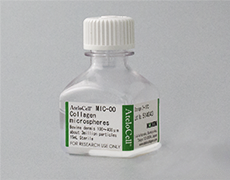Newsletters
Use of Collagen Microspheres for sustained release of growth factors and high-density cell culture
14 February 2018
In this edition of the newsletter, we summarize an article that used Atelocollagen Microspheres for sustained release of bFGF in a mouse model of lower limb ischemia.
Sustained release of bFGF using lyophilized Atelocollagen Microspheres
Article information
Fetal Therapy Model of Myelomeningocele with Three-Dimensional Skin Using Amniotic Fluid Cell-Derived Induced Pluripotent Stem Cells.
Kajiwara K, Tanemoto T, Wada S, Karibe J, Ihara N, Ikemoto Y, Kawasaki T, Oishi Y, Samura O, Okamura K, Takada S, Akutsu H, Sago H, Okamoto A, Umezawa A.
Stem Cell Reports. 2017 Jun 6;8(6):1701-1713. PMID: 28591652
Overview
Extracellular matrix is known to function as a growth factor reservoir, yielding inhibition of growth factor degradation, isolation of growth factor in an inactive state, and release of growth factor in response to an external stimulus.
However, type I collagen, which is a major part of the extracellular matrix, has been considered to have a lower affinity for growth factors compared to heparin and heparan sulfate.
Therefore, the biological importance of type I collagen in controlling growth factor release remains poorly defined.
On the other hand, growth factors in solution rapidly lose physiological activity; an effective delivery system is required when using growth factors for therapeutic purposes.
Therefore, the authors evaluated the retention and release of bFGF in vitro and in vivo by examining the interaction between bFGF and type I collagen.
First, in vitro evaluation using a collagen sponge showed that 70 to 80% of bFGF was adsorbed by the sponge, and it was observed that addition of bFGF to the dried sponge as compared with the swollen sponge suppressed the initial burst.
Next, bFGF was added to “microsponges” obtained by lyophilizing Atelocollagen Microspheres and transplanted into the hindlimb muscles of the lower extremities of ischemic mice.
It was found that the release period was approximately 3 days in the bFGF solution alone group and approximately 2 weeks in the bFGF + microsponge group.
In addition, a marked increase in blood flow was observed in the bFGF + microsponge group compared with the bFGF solution alone group.
Bead-like atelocollagen for sustained release of growth factor and high-density culture
Product Name
– Atelocollagen Microspheres (Cat. No.: MIC-00)
